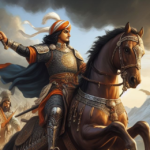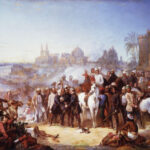The Maratha Empire was a powerful Hindu state that emerged in India in the 17th century and lasted until the mid-19th century. It was founded by the legendary warrior king Shivaji Bhosale in 1674 and went on to become one of the most dominant powers in India, controlling large parts of the subcontinent.
Under the leadership of Shivaji and his successors, the Maratha Empire expanded rapidly through conquest and diplomacy. Its military strength was based on the formidable Maratha cavalry, which was renowned for its speed and mobility. The empire was also known for its administrative and economic reforms, which contributed to its prosperity and stability.
The Maratha Empire played a significant role in Indian history, influencing the political, social, and cultural landscape of the subcontinent for centuries. Its legacy continues to inspire people in India and around the world, and it remains a symbol of strength, resilience, and cultural pride.
Shivaji Bhosale (1674-1680)
- Shivaji Bhosale founded the Maratha Empire in 1674 and became its first king.
- He was a brilliant military strategist and used guerrilla tactics to defeat much larger and more powerful enemies.
- Shivaji established a strong administrative system and reformed the military to create a powerful and efficient fighting force.
- He was a devout Hindu and was deeply committed to promoting Hindu culture and values throughout his empire.
- Shivaji was a patron of the arts and literature, and his court was known for its cultural vibrancy.
- He established a network of forts and strategic alliances to protect his territories from external threats.
- Shivaji waged a series of successful campaigns against the Mughal Empire, including the famous Battle of Pratapgarh in 1659, in which he defeated the Mughal general Afzal Khan.
- He captured important forts like Kondana and Raigad, which became the capital of the Maratha Empire.
- Shivaji’s reign was marked by his commitment to social justice and equality, and he worked to uplift marginalized communities like the lower castes and women.
- Shivaji’s legacy as a warrior king and visionary leader continues to inspire people in India and around the world today, and he is widely regarded as one of the greatest figures in Indian history.
Sambhaji Bhosale (1680-1689)

- Sambhaji Bhosale was the second king of the Maratha Empire, succeeding his father Shivaji after his death in 1680.
- Sambhaji faced several challenges during his reign, including conflicts with the Mughal Empire and internal dissent within the Maratha Empire.
- He was a capable military leader and waged several successful campaigns against the Mughal Empire, including the famous Battle of Wai in 1682.
- Sambhaji was known for his love of the arts and literature, and he patronized several poets and writers during his reign.
- He faced opposition from his own court, particularly from the powerful Maratha nobleman, Balaji Vishwanath, who later became a key figure in the empire’s administration.
- Sambhaji’s reign was marked by his efforts to expand the Maratha Empire’s territories and consolidate its power, despite facing internal and external threats.
- He was ultimately captured by the Mughal Emperor Aurangzeb in 1689 and executed for refusing to convert to Islam.
- Sambhaji’s legacy continues to inspire people in India today, particularly in Maharashtra, where he is revered as a hero and a symbol of Maratha pride.
- His reign marked a crucial period in the history of the Maratha Empire, as it transitioned from its founder, Shivaji, to a new generation of leaders who would shape its destiny for centuries to come.
-
Sambhaji’s tragic fate and his unwavering commitment to his people and his homeland serve as a reminder of the sacrifices and struggles that are often required in the pursuit of freedom and justice.
Rajaram Bhosale(1689-1700)
- Rajaram Bhosale was the younger half-brother of Sambhaji Bhosale and the third king of the Maratha Empire, succeeding Sambhaji after his execution by the Mughal Empire in 1689.
- During his reign, Rajaram faced significant challenges, including the ongoing conflict with the Mughal Empire, which had intensified following Sambhaji’s death.
- Rajaram was forced to flee his capital of Raigad and take refuge in the fortress of Jinji in southern India, where he continued to resist the Mughals and coordinate Maratha military campaigns.
- Despite facing overwhelming odds, Rajaram was a skilled strategist and was able to rally the Maratha forces and maintain their morale during a period of great uncertainty and adversity.
- Rajaram’s reign was marked by his efforts to expand the Maratha Empire’s territories, particularly in southern India, where he sought to establish a strong foothold and consolidate the Maratha’s power.
- Rajaram died in 1700, at the age of 33, from illness and exhaustion, having spent much of his reign in exile and on the run from the Mughal forces.
- Rajaram’s legacy continues to be celebrated in Maharashtra and other parts of India, where he is remembered as a valiant warrior and a symbol of Maratha pride and resilience.
- Despite the challenges he faced during his reign, Rajaram played a crucial role in preserving the Maratha Empire and paving the way for its future successes under the leadership of his widow, Tarabai, and his son, Shivaji II.
- Rajaram’s tragic fate and his unwavering commitment to the Maratha cause serve as a reminder of the sacrifices and struggles that are often required in the pursuit of freedom and justice.
- Today, Rajaram Bhosale is remembered as one of the most important figures in Maratha history, and his legacy continues to inspire people in India and around the world to strive for greatness and overcome adversity.
Shahu Bhosale (1707-1749)

- Shahu Bhosale was the grandson of Shivaji and the fifth king of the Maratha Empire, succeeding his father Sambhaji II after his death in 1707.
- Shahu was a significant figure in Maratha history, as he helped to consolidate and expand the empire’s territories and played a key role in shaping its political and social structures.
- Shahu’s reign was marked by his efforts to strengthen the Maratha Empire’s administration and establish a more centralized system of governance, which helped to promote stability and order across the empire.
- He also worked to foster greater religious tolerance and harmony within the empire, promoting the rights of all communities, including Muslims and non-Marathas.
- Shahu was a patron of the arts and literature, and he encouraged the development of Marathi language and culture, helping to establish it as a major force in Indian literature and the performing arts.
- His reign saw the emergence of several notable figures in Maratha history, including Peshwa Balaji Vishwanath, who became one of his most trusted advisors and played a key role in the empire’s administration.
- Shahu also faced significant challenges during his reign, including conflicts with the Mughal Empire, which threatened the stability and security of the Maratha Empire.
- Despite these challenges, Shahu was a skilled diplomat and military strategist, and he was able to successfully navigate the complex political landscape of 18th century India.
- His reign marked a crucial period in Maratha history, as the empire consolidated its power and expanded its territories, becoming one of the most powerful and influential forces in the region.
- Shahu Bhosale’s legacy continues to be celebrated in Maharashtra and other parts of India, where he is remembered as a visionary leader who helped to shape the course of Maratha history and culture for generations to come.

Baji Rao I (1720-1740)
- Baji Rao I was born the eldest son of Peshwa Balaji Vishwanath and became the second Peshwa of the Maratha Empire, serving from 1720 to 1740.
- He is widely regarded as one of the greatest warriors and statesmen of the Maratha Empire, and his reign marked a period of significant expansion and consolidation.
- Baji Rao I is credited with laying the foundation for the Peshwa dynasty’s rise to power, and his military campaigns helped establish the Maratha Empire as one of the most powerful and influential forces in India.
- During his reign, Baji Rao I led several successful military campaigns against the Mughal Empire, including the Battle of Bhopal in 1737, which cemented Maratha control over northern India.
- He was known for his administrative and organizational skills, helping to establish a more efficient and centralized system of governance across the Maratha Empire.
- Baji Rao I was a patron of the arts and literature, and he played a significant role in promoting Marathi culture and language.
- He is remembered for his contributions to Maratha society, including the establishment of the Brahmin Peshwa rule and the development of a new code of laws and regulations that promoted stability and order across the empire.
- Despite his successes, Baji Rao I faced significant challenges during his reign, including conflicts with other Maratha leaders and threats from external forces such as the Nizam of Hyderabad and the Portuguese.
- He was a skilled military strategist, and his tactics and innovations in warfare are still studied and admired today.
- Baji Rao I was known for his valor and courage, and he personally led his troops into battle on numerous occasions.
- His reign saw the establishment of the Maratha Confederacy, which helped to unite the various Maratha chiefs and leaders under a single banner.
- Baji Rao I was a proponent of Hindu nationalism and worked to promote Hindu culture and traditions throughout the Maratha Empire.
- He established a network of spies and informants, which helped him to stay one step ahead of his enemies and to identify potential threats to his rule.
- Baji Rao I was a skilled negotiator, and he was able to secure several important alliances with other Indian rulers, including the Rajputs and the Sikhs.
- He was a patron of the Maratha navy, and under his leadership, the navy became a powerful force in the Arabian Sea and played a significant role in defending the Maratha Empire’s coastline.
- Baji Rao I was a prolific builder, and his reign saw the construction of several important landmarks and monuments, including the Shaniwar Wada in Pune.
- He was a devout Hindu, and he undertook several religious pilgrimages throughout his life, including to the holy city of Varanasi.
- Baji Rao I was a visionary leader who understood the importance of education and learning, and he established several schools and colleges throughout the Maratha Empire.
- He was known for his fairness and justice, and he worked tirelessly to ensure that all members of society were treated equally under the law.
- Baji Rao I died in 1740 at the age of 39, leaving behind a legacy as one of the greatest and most influential figures in Maratha history. His legacy continues to be celebrated in Maharashtra and other parts of India, where he is remembered as a visionary leader and a symbol of Maratha pride and resilience.
Balaji Baji Rao I (1740-1761)

- Balaji Baji Rao I, also known as Nana Saheb, was the third Peshwa of the Maratha Empire, serving from 1740 to 1761.
- He was the son of Baji Rao I, and he continued his father’s legacy of expanding and consolidating the Maratha Empire.
- Balaji Baji Rao I is widely regarded as one of the most successful Peshwas, and his reign saw the Maratha Empire reach its zenith of power and influence.
- He is credited with leading several successful military campaigns against the Nizam of Hyderabad, the Mughal Empire, and other regional powers
- Balaji Baji Rao I was a skilled administrator, and he worked to establish a more centralized and efficient system of governance across the Maratha Empire.
- He was a patron of the arts and literature, and he played an important role in promoting Marathi culture and language.
- Balaji Baji Rao I is remembered for his contributions to Maratha society, including the establishment of the Peshwa court and the development of a new code of laws and regulations.
- Despite his successes, Balaji Baji Rao I faced several challenges during his reign, including conflicts with other Maratha leaders and threats from external forces such as the British East India Company.
- He was a skilled diplomat, and he was able to negotiate several important treaties with other Indian rulers and European powers.
- Balaji Baji Rao I was a proponent of Hindu nationalism, and he worked to promote Hindu culture and traditions throughout the Maratha Empire.
- He was a supporter of education and learning, and he established several schools and colleges throughout the Maratha Empire.
- Balaji Baji Rao I was known for his fairness and justice, and he worked to ensure that all members of society were treated equally under the law.
- He was a devout Hindu, and he undertook several religious pilgrimages throughout his life, including to the holy city of Varanasi.
- Balaji Baji Rao I was a skilled builder, and his reign saw the construction of several important landmarks and monuments, including the Parvati Temple in Pune.
- He was a patron of the Maratha navy, and under his leadership, the navy became a powerful force in the Arabian Sea and played an important role in defending the Maratha Empire’s coastline.
- Balaji Baji Rao I was a strong supporter of agriculture and worked to improve farming practices and irrigation systems throughout the Maratha Empire.
- He was a proponent of women’s rights, and he worked to improve the status of women in Maratha society.
- Balaji Baji Rao I died in 1761, during the Third Battle of Panipat, which was a major turning point in the history of the Maratha Empire.
- His legacy continues to be celebrated in Maharashtra and other parts of India, where he is remembered as a visionary leader and a symbol of Maratha pride and resilience.
- Balaji Baji Rao I’s contributions to Maratha history and culture have had a lasting impact, and he remains an important figure in Indian history.

Madhav Rao I
- Madhav Rao I was the fourth Peshwa of the Maratha Empire, serving from 1761 to 1772.
- He was the son of Narayan Rao, who was assassinated by his own uncle Raghunath Rao in a power struggle for the Peshwa throne.
- Madhav Rao I was just 16 years old when he was appointed Peshwa, but he proved to be a skilled administrator and military strategist.
- He is credited with restoring stability to the Maratha Empire after the devastating defeat at the Third Battle of Panipat in 1761.
- Madhav Rao I was a patron of the arts and literature, and he supported the development of Marathi language and culture.
- He was a proponent of religious tolerance, and he worked to promote harmony between Hindus and Muslims.
- Madhav Rao I was a skilled diplomat, and he negotiated several important treaties with other Indian rulers and European powers.
- He was a supporter of education and learning, and he established several schools and colleges throughout the Maratha Empire.
- Madhav Rao I was a patron of agriculture, and he worked to improve farming practices and irrigation systems throughout the Maratha Empire.
- He was a strong advocate for the rights of women and lower castes, and he worked to improve their status in Maratha society
- Madhav Rao I was a proponent of military reform, and he worked to modernize the Maratha army and improve its tactics and equipment.
- He was a devout Hindu, and he undertook several religious pilgrimages throughout his life.
- Madhav Rao I died in 1772, at the young age of 28, and his death was a major blow to the Maratha Empire.
- His legacy continues to be celebrated in Maharashtra and other parts of India, where he is remembered as a visionary leader and a symbol of Maratha pride and resilience.
- Madhav Rao I’s contributions to Maratha history and culture have had a lasting impact, and he remains an important figure in Indian history.
Astapradhan
“Astapradhan” or “Ashtapradhan” refers to the council of eight ministers who served under the Maratha king Shivaji (1630-1680) in his administration. The term “Ashtapradhan” is derived from two Sanskrit words: “ashta,” meaning eight, and “pradhan,” meaning minister or chief.
The eight ministers who formed the Ashtapradhan were:
- Peshwa: The prime minister or chief advisor to the king.
- Amatya: The finance minister and chief accountant.
- Sachiv: The secretary or chief of staff.
- Mantri: The foreign affairs minister and chief diplomat.
- Senapati: The commander-in-chief of the army.
- Nyayadhish: The chief justice or head of the judiciary.
- Panditrao: The high priest or head of the religious council.
- Samant: The chief of the nobility or feudal lords.
These eight ministers formed the backbone of Shivaji’s administration and were responsible for governing the kingdom efficiently and effectively. They were chosen based on their merit, loyalty, and administrative capabilities.






